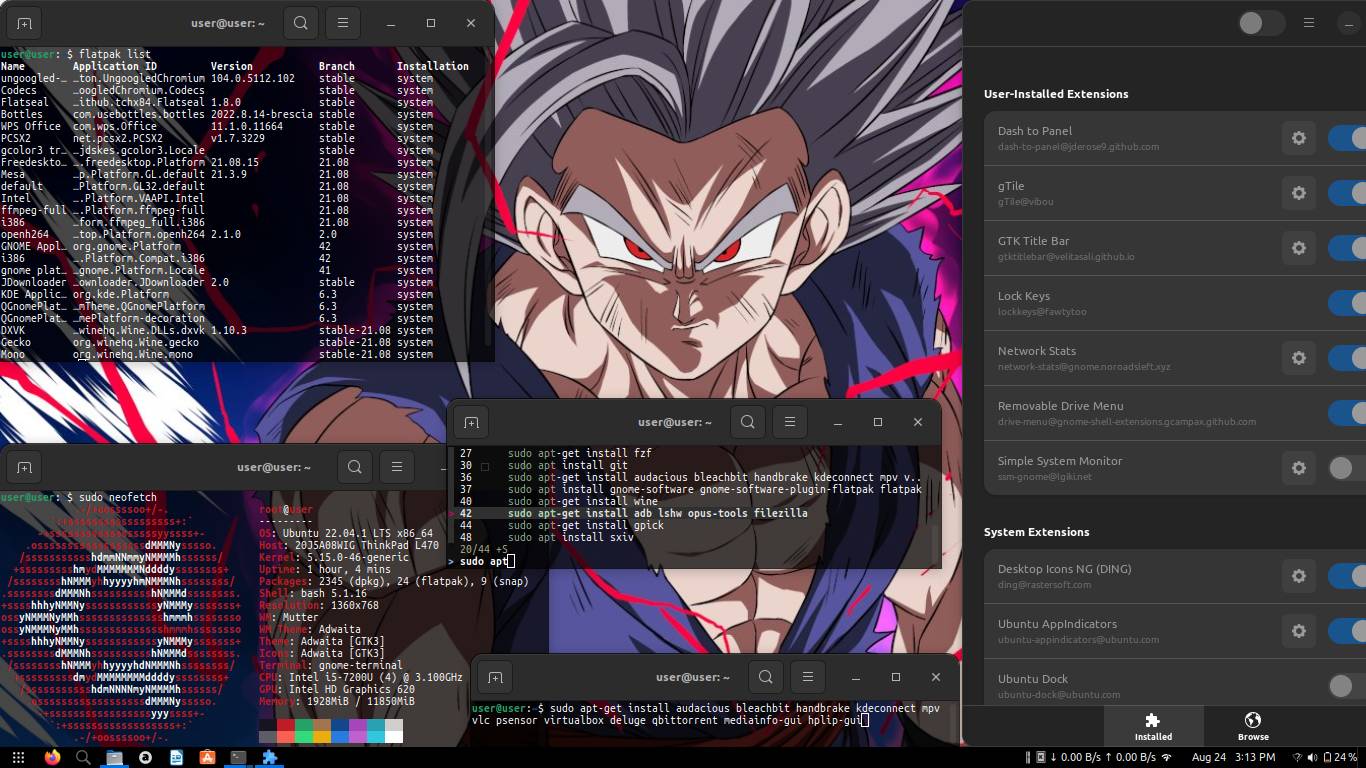If this is in the wrong community let me know, but I have been away from linux for a little while now, and I have decided to come back to it. I am trying to figure out what Distro and Desktop environment I should use.
I used to use Ubuntu and, Ubuntu based Distributions, though for various reasons I had bad experiences with the ones based down stream of Ubuntu, I have also heard that Ubuntu is no longer nearly as good as they where before. As for desktop Experences, I never really liked Gnome. That being said from what I can tell there has been quite a bit that has changed sense I left, and any recommendations would be much appreciated.
Debian is very easy to use, especially if you don’t want to download any proprietary software. If you don’t like using the terminal, I’d recommend Xfce or something like that
someone was on a downvoting spree here
they’ve struck again
I use Manjaro.
Standard comes with XFCE.
It’s a rolling release and it’s package manager in my view is superior to apt, due to it’s better options to search for new packages, installed packages and files in packages,
and being a deritave of Arch Linux, you can use Arch Linux documentation, which is one of the best documentations on installing and configuring Linux apps, making it easier for you to fix things yourself.
Don’t use the Arch Linux forum though, Manjaro forum is good enough for that and the Arch Linux team are (understandably) quite grumpy.For something easy, Linux Mint with cinammon or xfce, or MATE, since you say you don’t like gnome. Linux mint is easy to use and based on ubuntu/debian so lots of software available, and mint is user friendly. It also has cool tools like timeshfit and warpinator.
If you feel more comfortable with linux, Debian is a great choice. Either stable with backports and flatpak, or use the unstable branch (sid).
Desktop environment all depends on your preferences. You say you don’t like gnome, after that it’s just if you like traditional desktops or are interested in something more minimal, like tiling. My own preferences:
DE: XFCE or MATE
WM: cwm (https://man.openbsd.org/cwm.1) ctwm, fluxbox, xmonad (tiling window manager)
I can’t give cwm enough of a recommend if you like things that are minimal and stay out of your way.
No matter what I try, I always end up back on Mint, with Cinnamon desktop. It just seems to require the least amount of fuss and configuration to set up and get comfy in. In the past, I enjoyed Fedora, and I did use Manjaro for awhile when for some reason, it was the only distro I could get to install on my aliexpress minipc.
I use plain debian with cinnamon in one of my VMs. Can’t complain.
actually had to unblacklist the wifi driver and you need to modify apt sources and add non-free. you can also make it a rolling release that way
That’s cool. I can see myself ending up there actually.
How hard is Debian to set up? I have heard it is a bit of a pain to do
debian is easy to set up imo. There is a graphical install if that helps
The graphical installer is more or less like any other… (It let’s you pick a DE like Gnome, Cinnamon, XFCE4, etc…) The difficulty is with enable’ing non-free packages. Go to /etc/apt/sources.list and add non-free to the repo lines. That should be it but don’t be afraid to ask.
After you do that it should be about as usable as the other debian distros but without the bloat and bs. I’ve been using it to run my wallets, play steam games, etc.
I think it’s useful to install the “non-free” Debian because then you can configure WiFi easily
deleted by creator
over the years, i went from ububtu/debian stuff too arch to gentoo and now i use alpine for the musl-libc benefit vs. glibc
for a wm, have stuck to i3-gaps/rofi setup for quite a while, with no bar and no dm. simple and resource efficient custom setup
i did check out a lot of other os’s at some point, just poking around distrowatch, theres some cool new stuff
theres been a lot of development surrounding nixos and especially nixshell that is being used for a lot. can use nixshell and its benefits outside of nixos as well
if you are interested in declarative configuartion like nixos, guix is doing very cool stuff with the guile scheme language. very cool how it comes together, very much like emacs
Do you run Alpine on bare metal or in a VM?
its a hand-me-down laptop i got from someone like ten years ago
Do you use it for anything graphical, or just for the terminal?
xorg runs on it fine enough on its own. the laptop struggles with anything more intensive tho, like ff or even just running a gba emulator. can’t play anything past a gba game. use the terminal for as much as i can (urxvt ftw!)
(ff?) I wonder how much of that is due to missing drivers (etc.) for Alpine and how much is just the hardware being old
modern browsers are super resource intensive, they just got so bloated, and do so much. just dont have enough ram or cpu clock speed to do better. there’s no driver issues with alpine, drivers are a standard outside of any os thats really simple to bring in. the laptop is from, like, 2007 (?), it was a windows vista oem laptop
They really are incredibly bloated. Even the less popular graphical ones still have to use a massive browser engine like WebKit to support modern websites
(also, just realized that “ff” meant Firefox)
what do you think is the benefit of libc over glibc? Genuine question, since that’s not something I consider.
link to musl-libc website, the about page goes over why a little more clearly
tldr: musl-libc aims to be safer, more correct, and more efficient. there are criticisms of glibc that it has become bloated and not properly managed, leading to classes of exploits and inefficiencies which are really difficult to address due to regression/compatibility/r&d resources available to the project.
the down side of using a musl-libc system is that most applications are only really built for glibc, and much software require patching. the alpine dev team has put in a lot of work to get things like firefox into the repositories. there is also slightly less software available. makes it difficult to explore new projects on your own that require glibc because you will have to gain a higher level understanding of the difference in the toolchain, and how to patch things on your own. then there’s no convenience to use tools with proprietary blobs, like, if you need zoom software for some reason.
with that being said, i have been using alpine for almost a year now (about?), and i really love it. if a type of malware is compiled with glibc toolchain, it won’t work on this system :). it’s been fun to explore, and i learned some cool things from it
Fedora with a spin if you don’t want a Gnome DE.
Debian for stability if your computer doesn’t need any proprietary drivers. I’ve heard a lot of good things about Fedora lately, regarding the age of their packages whilst still maintaining a significantly higher stability than Ubuntu. They have what they call Spins to change the default desktop environment for the OS. For a quick and easy setup, you can always go Mint, the bonus here is that they have a contingency plan for if things go bust with Ubuntu. I’ve heard too many negative things about Manjaro to really recommend them right now, but, being based off Arch, they still have painfully new packages. Of course their is just strait Arch if you want it, but it’s stability leaves a lot to be desired.
Tip I would give to anyone who wants to buy a laptop and get Linux : Chromebooks are cheaper because they don’t have a Windows licence included, instead they have ChromeOS which is free. So instead of paying for a Windows licence and throw it away you can pick a Chromebook and install GalliumOS. It is a lightweight and specialised distro it runs super good on very low-end laptops.
I use Zorin OS, it’s not super duper privacy oriented but it’s miles better than windows/Mac and it’s good, high quality, I get the ease of use and ux of windows and the features of Linux, win-win in my book.
What type of device and for what sort of usage?
I ordered a new laptop (Thinkpad E15 [intel]), this is going to be my primary device.
I can recommend Debian because I have used it. It would be a solid base and personally I like to offload complex stuff to containers and VMs. Might consider Funtoo or NixOS but I haven’t used them yet personally. I’m typing on arch rn, I don’t think it’s quite as stable as debian unless you really want the AUR, still useful on certain constrained/edge environments.
Garuda could be cool but a bit experimental last time we used it.
MX Linux
I use Linux Mint Cinnamon. I know there’s probably better choices, but it works for me with little complaints.
I have to kill pulseaudio (pulseaudio -k) to fix an audio bug every so often.
My system freezes if it’s left idol all day while I’m at work requiring a hard reset.
I had to delete a file at one point in order to set the system resolution to 1080. My monitor is 4k. The GUI doesn’t know how to deal with that so everything is really tiny unless you do that.
A major bug I ran into a while back was when my kernel partition overflowed. It broke everything. I needed to seek advanced help from the forum. I have the solution saved in a file somewhere. Basically in order to delete a file Linux (or at least that particular partition) needs to create a temporary file. If there isn’t space to create a temporary file then it can’t delete anything.
The built in repositories are woefully out of date. So you need to learn how to add repos preferably directly from the developers.
Otherwise my experience with Mint over the past 6 or so years (three generations of the OS) have been good. Nothing’s perfect. There are usually easy solutions to any problem as long as you’re aware of that solution. Delete this one file or use this one command is super simple as long as you’re aware of it.
Ubuntu 22.04 GNOME. Also, this fresh guide is just in time for you. https://lemmy.ml/post/511377
Went to Mint, came back.
My ThinkPad:











